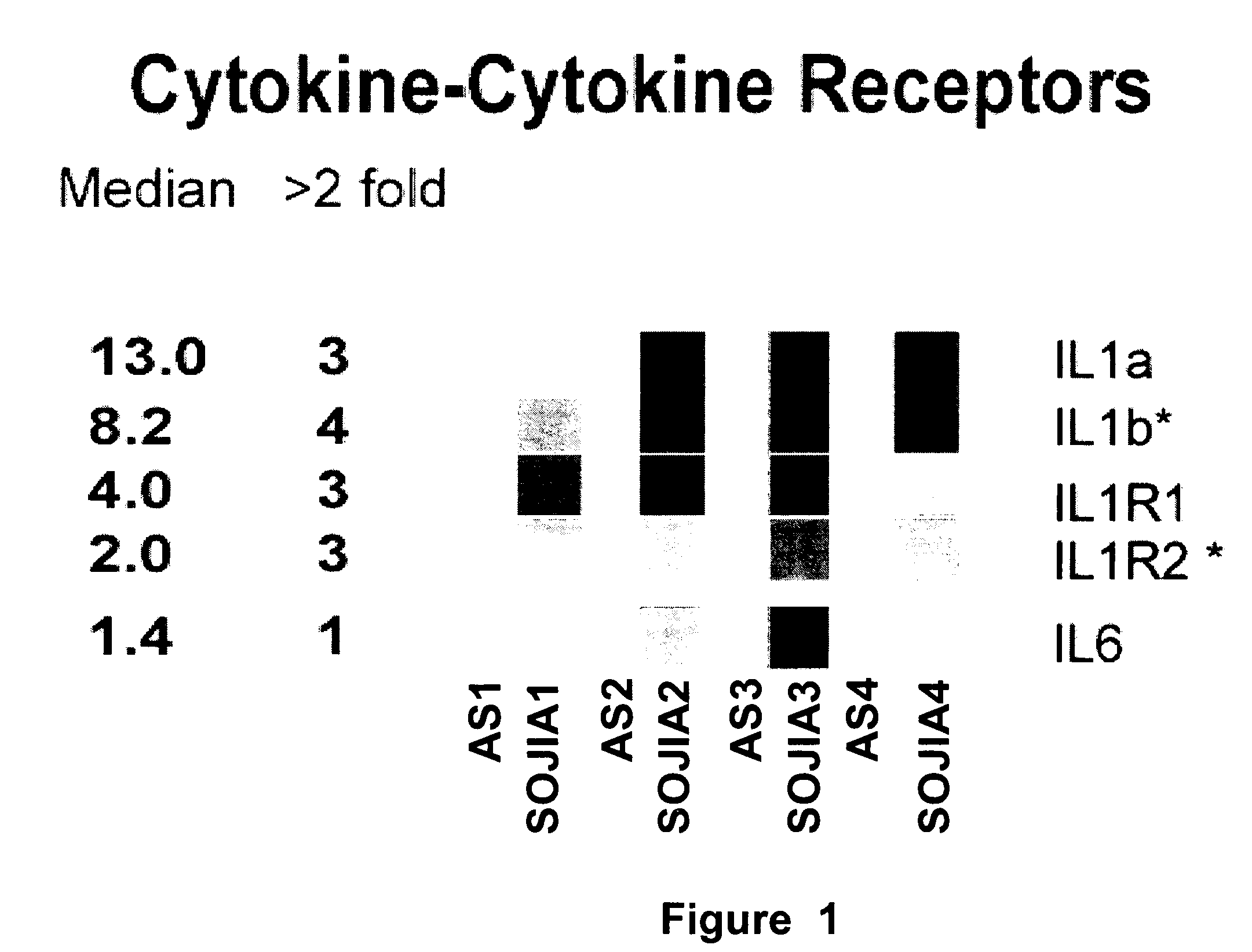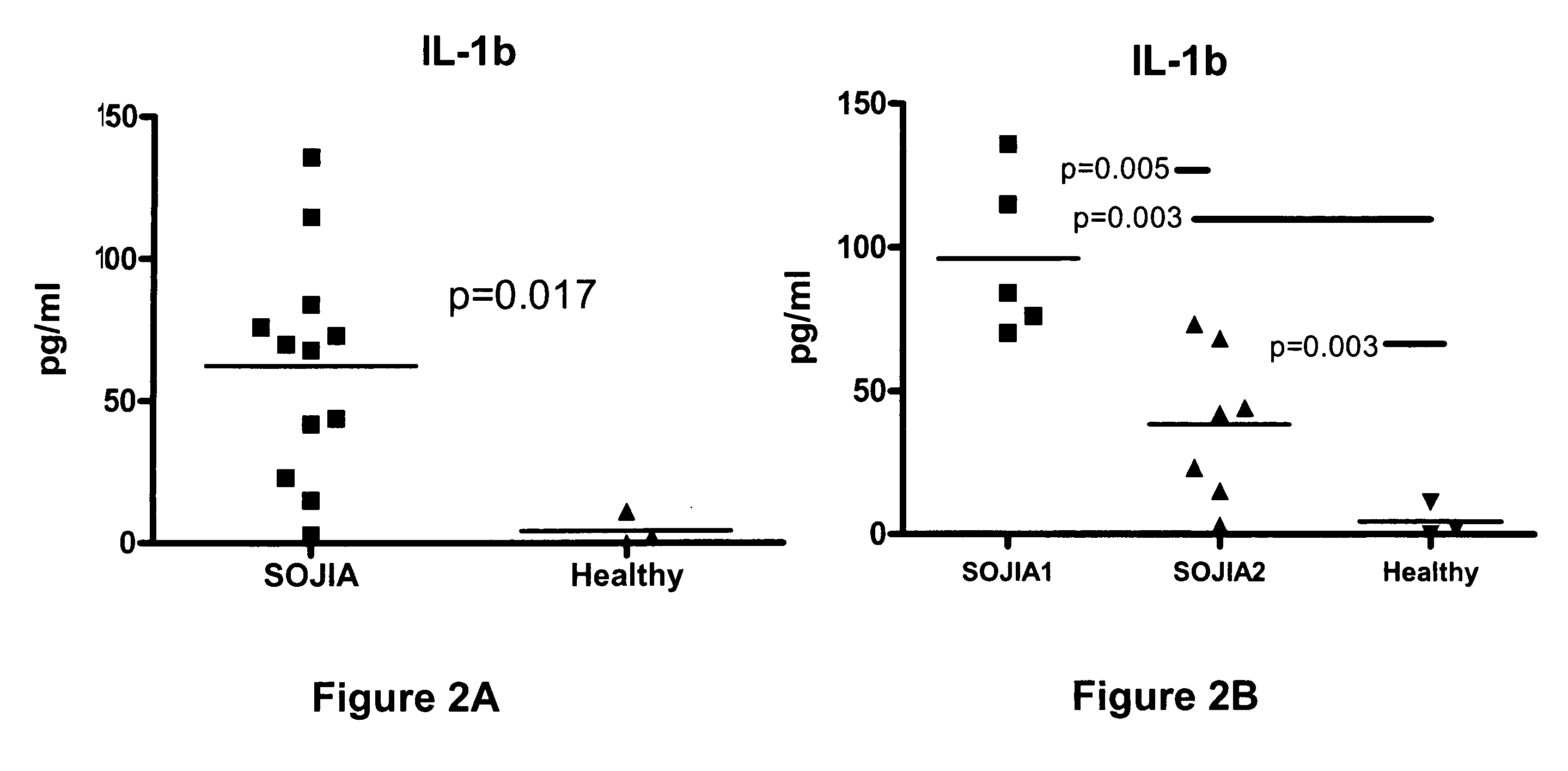Compositions and methods for the systemic treatment of arthritis
a systemic treatment and composition technology, applied in the field of bioaffecting and bodytreating compositions, can solve the problems of limited and risk associated with these drugs, impaired ability of patients to eliminate viral infections, and risk of intravenous immunoglobulin treatment, so as to reduce or block effective therapeutic treatment, and the effect of reducing or blocking the bioavailability of interleukin-1 beta
- Summary
- Abstract
- Description
- Claims
- Application Information
AI Technical Summary
Benefits of technology
Problems solved by technology
Method used
Image
Examples
example 1
[0042] Incubation of healthy PBMCs with SOJIA serum induces the transcriptional upregulation of Interleukin 1β. The gene expression profile was analyzed for healthy donor PBMCs before and after incubation with autologous serum or serum from two untreated and two treated SOJIA patients for six hours in vitro. After incubation with the serum, the PBMCs were processed to extract the RNA, and the RNA was hybridized to Affymetrix U133 A and B microarray chips. In this way, a wide array of genes whose transcription would be up-regulated or down-regulated with the SOJIA serum was screened.
[0043] Patient Population. PBMCs and sera from 23 SOJIA patients (15 females, 8 males, average age 7.1 years) fulfilling the ACR diagnostic criteria34 were collected on repeated occasions. Patients were classified as active if they had systemic symptoms (fever and / or rash) and / or active arthritis (swollen and / or tender and limited joints). The control population consisted of 12 children (average 14 years...
example 2
[0053] Interleukin 1β treatment of SOJIA patient. A 17 year old Hispanic female diagnosed with SOJIA at the age of 15 was treated according to the method of the present invention. She presented with persistent (>2 month) daily fever, a generalized pruritic rash and joint pain. On exam, she had swelling and limitation of the radio-carpal and carpal-metacarpal joints bilaterally. Her laboratory tests revealed high white blood cell count (WBC), low hemoglobin (Hgb), high platelets (Plts) and elevated erythrocyte sedimentation rate (ESR). An extensive infectious disease work up yielded negative results. The patient received oral and IV high dose methyl prednisolone and eventually was placed on methotrexate. Her symptoms improved, and the patient was asymptomatic for several months during which the steroid treatment was slowly tapered. A few months later the symptoms recurred. Steroids were reinitiated without success. Anti-TNF IV therapy (Infliximab) was tried at a dose of 5 mg / kg every...
example 3
[0054] Interleukin 1β treatment of SOJIA patient. A 9 year old Hispanic male was diagnosed with SOJIA at the age of 7, when he presented with prolonged daily spiking fever, rash, pericarditis and joint and muscle pain. Laboratory tests showed high WBC, low Hgb, high platelets and elevated ESR. Bone marrow analysis and an extensive infectious work up failed to yield a specific diagnosis. The patient was treated with high dose IV methylprednisolone, and symptoms improved. Over the next two years, the patient presented flares and remissions. The last flare did not respond to high dose steroids, and the patient developed swelling over the radio-carpal joints bilaterally. Therapy with IL-1 antagonist Anakinra was initiated at a dose of 50 mg (0.5 cc) as a subcutaneous daily injection. The day after the first subcutaneous injection, the patient became asymptomatic, with the disappearance of fever, rash, joint pain and swelling, and he remained free of symptoms for over 3 months.
PUM
| Property | Measurement | Unit |
|---|---|---|
| Mass flow rate | aaaaa | aaaaa |
| Cell angle | aaaaa | aaaaa |
| Biological properties | aaaaa | aaaaa |
Abstract
Description
Claims
Application Information
 Login to View More
Login to View More - R&D
- Intellectual Property
- Life Sciences
- Materials
- Tech Scout
- Unparalleled Data Quality
- Higher Quality Content
- 60% Fewer Hallucinations
Browse by: Latest US Patents, China's latest patents, Technical Efficacy Thesaurus, Application Domain, Technology Topic, Popular Technical Reports.
© 2025 PatSnap. All rights reserved.Legal|Privacy policy|Modern Slavery Act Transparency Statement|Sitemap|About US| Contact US: help@patsnap.com



